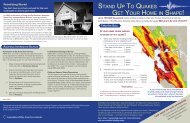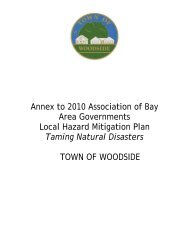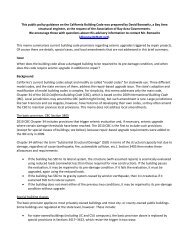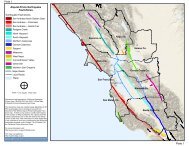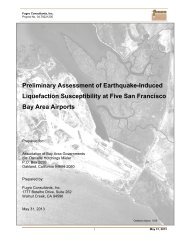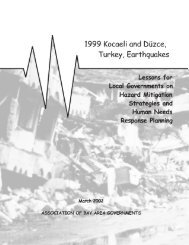Safe Enough to Stay - ABAG Earthquake and Hazards Program
Safe Enough to Stay - ABAG Earthquake and Hazards Program
Safe Enough to Stay - ABAG Earthquake and Hazards Program
- No tags were found...
Create successful ePaper yourself
Turn your PDF publications into a flip-book with our unique Google optimized e-Paper software.
<strong>Safe</strong> <strong>Enough</strong> <strong>to</strong> <strong>Stay</strong>Section III:What needs <strong>to</strong> be done <strong>to</strong>enable residents <strong>to</strong> shelter inplace for days <strong>and</strong> monthsafter a large earthquake?After an earthquake, we want San Franciscans <strong>to</strong> shelter in place intheir homes. Yet, while a building may be structurally safe enough<strong>to</strong> occupy following a seismic event, it may be considered unsafe orsubst<strong>and</strong>ard under the applicable codes, 36 because it won’t meetthe existing minimum st<strong>and</strong>ards for health <strong>and</strong> safety for residentialhousing in non-emergency times. How do we set a post-earthquakest<strong>and</strong>ard that is “safe enough” yet not so stringent that people are <strong>to</strong>ldunnecessarily <strong>to</strong> vacate their homes <strong>to</strong> find temporary shelter?SPUR believes it is critical <strong>to</strong> define alternative shelter-in-placehousing st<strong>and</strong>ards that allow people <strong>to</strong> stay in their homes safely butdon’t deem otherwise safe buildings unsuitable for occupancy. Thesealternative st<strong>and</strong>ards would supersede regular code requirementsduring a housing-emergency period declared by the city after a majorearthquake. Such an emergency period might extend for days, weeksor longer.Shelter-in-place alternative st<strong>and</strong>ards could significantly reduceemergency-shelter <strong>and</strong> interim-housing needs while maintaining thelocal population base necessary <strong>to</strong> support recovery. The alternativest<strong>and</strong>ards should become more stringent as San Francisco recoversafter the earthquake <strong>and</strong> should remain in force until the city’shousing s<strong>to</strong>ck is completely res<strong>to</strong>red.Shelter-in-place st<strong>and</strong>ards should be “phased,” with the expectationthat repairs need <strong>to</strong> be made over time <strong>to</strong> res<strong>to</strong>re habitability. Forexample, certain st<strong>and</strong>ards that will be considered acceptableimmediately following the earthquake (such as using portable outdoor<strong>to</strong>ilets) will not be acceptable three months after the earthquake. Theshelter-in-place st<strong>and</strong>ards should define which needs will be metby the building itself <strong>and</strong> which will be met outside the building foreach time phase. Those resources that must be accessible outsidethe building will have <strong>to</strong> be provided in a neighborhood service centerlocated in close proximity <strong>to</strong> shelter-in-place housing.Figure 5 illustrates the idea of alternative habitability st<strong>and</strong>ardsthat would apply in emergencies <strong>and</strong> gradually revert <strong>to</strong> normalcode requirements. The blue line represents the code st<strong>and</strong>ards forhabitability that normally apply. When an earthquake occurs, somedamage might result, but if the damage is light, it will not affect thecity’s overall resilience, so no relaxation of the normal st<strong>and</strong>ardswould be justified. A declared housing emergency, however, indicatesthat damage — <strong>and</strong> possibly housing loss — is significant enough<strong>to</strong> justify special measures <strong>to</strong> speed response <strong>and</strong> recovery. Thestepped red line represents the minimum st<strong>and</strong>ards <strong>to</strong> be metwithin a residence. The pink shaded area represents resources thata neighborhood service center provides outside the home. The redshaded area represents the actual loss of habitable housing. Asrepairs are made, buildings (<strong>and</strong> housing st<strong>and</strong>ards) return <strong>to</strong> normal.One of the challenges in developing <strong>and</strong> implementing shelter inplacest<strong>and</strong>ards is that these alternative st<strong>and</strong>ards do not correspondwith any currently adopted st<strong>and</strong>ards in San Francisco’s BuildingCode, Housing Code or other codes. Once San Francisco has adoptedshelter in place as a performance goal for new <strong>and</strong>/or existingbuildings, local building codes will need <strong>to</strong> be amended.Minimum habitability requirements for occupancyafter the earthquakeWhen should a building be considered acceptable for shelter in place?Conditions that are adequate right after the earthquake may not beacceptable one <strong>to</strong> three months down the road. SPUR has identifiedfive different post-earthquake time periods <strong>and</strong> defined the majorhabitability requirements for each:1. The immediate post-earthquake period2. One week after the earthquake3. One month after the earthquake4. Three months after the earthquake5. After the declared housing emergency is overIncreasingly robust habitability st<strong>and</strong>ards will need <strong>to</strong> be met in eachphase, as described in Figure 6 (page 28).Even if all of the alternative st<strong>and</strong>ards are met, however, people maychoose not <strong>to</strong> shelter in place. There is no obligation under thesealternative regulations for any person <strong>to</strong> remain in any residence; anyperson might choose <strong>to</strong> relocate <strong>to</strong> emergency or temporary shelter,move <strong>to</strong> an undamaged facility or make other arrangements.36 The minimum st<strong>and</strong>ards for health <strong>and</strong> safety for residential occupancy atnon-emergency times are detailed in the California Health <strong>and</strong> <strong>Safe</strong>ty Code <strong>and</strong>in the San Francisco Housing Code.26 SPUR Report > January 2012



